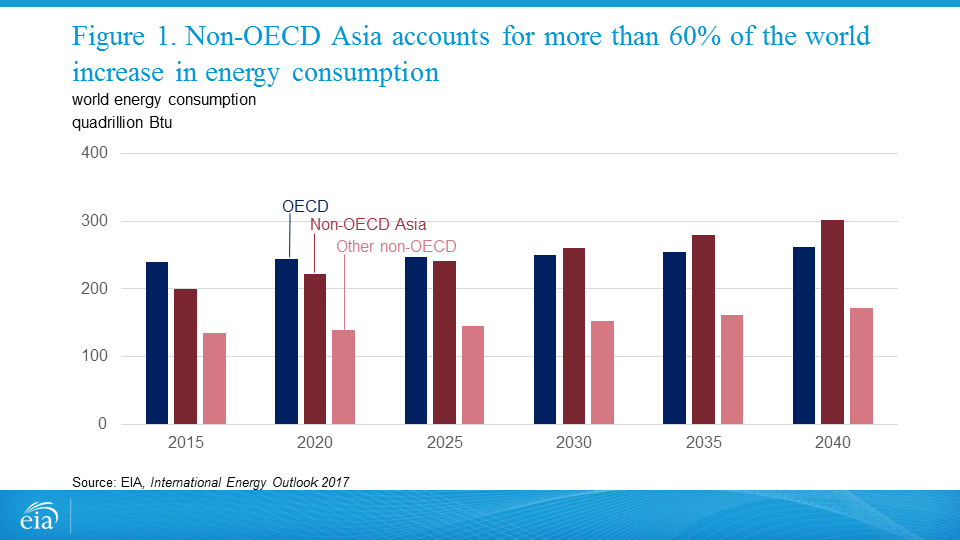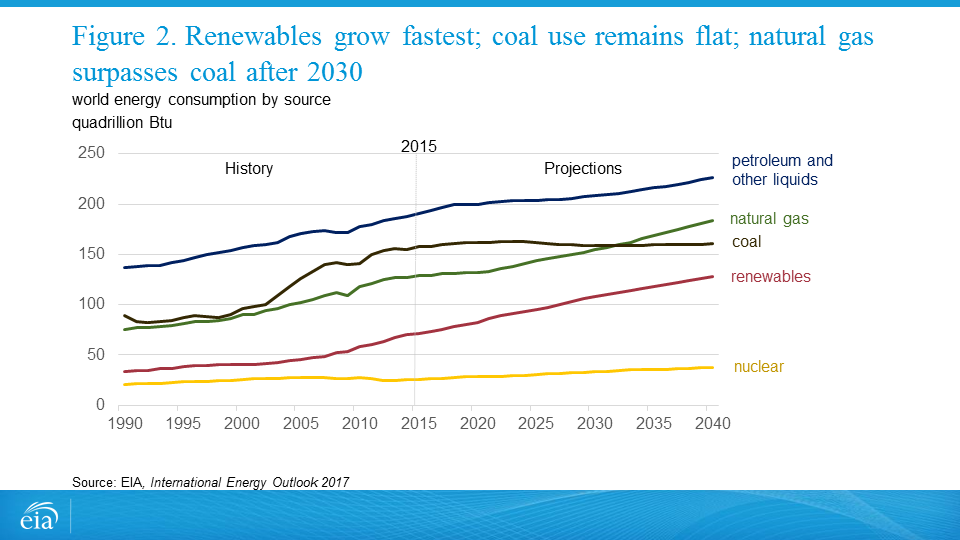
U.S. ENERGY INFORMATION ADMINISTRATION
WASHINGTON DC 20585
FOR IMMEDIATE RELEASE
September 14, 2017
Emerging Asian economies drive the increase in world energy use from 2015 to 2040
World energy consumption is projected to increase by 28% by 2040, according to the International Energy Outlook 2017 (IEO2017), released today by the U.S. Energy Information Administration (EIA). Most of the world’s growth in energy demand is projected to take place in countries outside of the Organization for Economic Cooperation and Development (OECD). China and the other non-OECD Asia nations alone account for more than 60% of the projected increase in world energy demand (Figure 1).
"Transportation energy use rises by nearly 30%, with almost all of the growth coming from non-OECD countries, as personal incomes rise and energy markets in many of these nations' rapidly growing economies become further integrated into global supply chains," said Ian Mead, EIA’s Assistant Administrator for Energy Analysis.
Some key findings:
World energy use increases from 575 quadrillion British thermal units (Btu) in 2015 to 736 quadrillion Btu in 2040. The increase mainly occurs in the emerging economies of the world, driven by long-term growth in economies and populations.
In the IEO2017 Reference case, world net electricity generation increases by 45% from 23.4 trillion kilowatthours (kWh) in 2015 to 29.4 trillion kWh in 2030 and to 34.0 trillion kWh in 2040. Electricity is the world’s fastest growing form of end-use energy consumption, as it has been for decades, and power systems continue to evolve from isolated, noncompetitive grids to integrated and even international markets.
IEO2017 projects renewables as the world's fastest-growing energy source—increasing by 2.3% per year through 2040—but fossil fuels still account for more than three-quarters of world energy use (Figure 2). Although petroleum and other liquids remain the largest source of energy, the liquid fuels share of world marketed energy consumption falls from 33% in 2012 to 31% in 2040.
Natural gas is the fastest-growing fossil fuel in the outlook. Global natural gas consumption grows by 1.4% per year from 2015 to 2040. Abundant natural gas resources and rising production—including supplies of tight gas, shale gas, and coalbed methane—contribute to the strong competitive position of natural gas.
Compared with the strong growth in coal use in the 2000s, worldwide coal use remains essentially flat through 2040. After 2030, natural gas surpasses coal to become the world's second-largest energy source after liquid fuels (Figure 2).
Other IEO2017 highlights:
By 2040, renewables provide the largest share (34%) of world electricity generation—a substantial change from 2015, when coal provided 40% of all power generation. Hydropower and wind are the two largest contributors to the increase in world electricity generation from renewable energy sources, together accounting for two-thirds of the total increase from 2015 to 2040. Hydropower and wind generation each increase by about 1.8 trillion kilowatthours (kWh) in the IEO2017 Reference case.
The top three coal-consuming countries—China, the United States, and India—together account for more than 65% of the world's coal use through 2040. China alone currently accounts for slightly more than half of the world's coal consumption, but a slowing economy and plans to implement policies to address air pollution and climate change mean that coal use in China will decline over the projection period. Of the world's three largest coal consumers, only India is projected to increase coal use through 2040.
Worldwide electricity generation from nuclear power increases from 2.5 trillion kWh in 2012 to 3.7 trillion kWh in 2040, as concerns about energy security and greenhouse gas emissions support the development of new nuclear generating capacity, but reactor retirements and opposition from local populations keep nuclear from expanding in many parts of the world. Virtually all of the projected net growth in the world's installed nuclear capacity occurs in non-OECD countries, led by China's addition of 111 gigawatts of nuclear capacity from 2015 to 2040.
The industrial sector continues to account for the largest share of delivered energy consumption, using more than half of global delivered energy in 2040.
Worldwide energy-related carbon dioxide emissions rise from 34 billion metric tons in 2012 to 39 billion metric tons in 2040, a 16% increase from 2015 to 2040. Much of the growth in emissions is attributed to non-OECD nations, many of which continue to rely on fossil fuels to meet the growth in energy demand.
IEO2017 is available at http://www.eia.gov/ieo/.
EIA Program Contact: Linda Doman, 202-586-1041, linda.doman@eia.gov
EIA Press Contact: Jonathan Cogan, 202-586-8719, jonathan.cogan@eia.gov
EIA-2017-04


